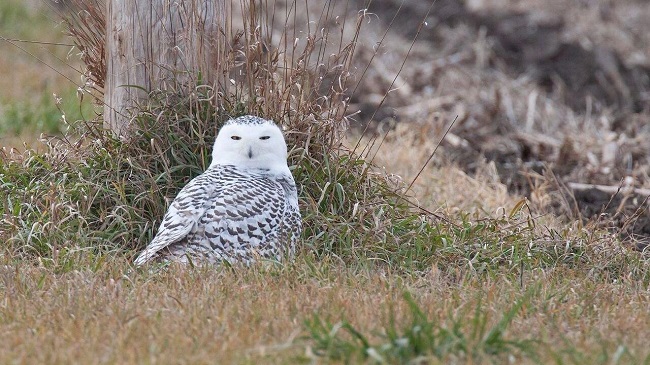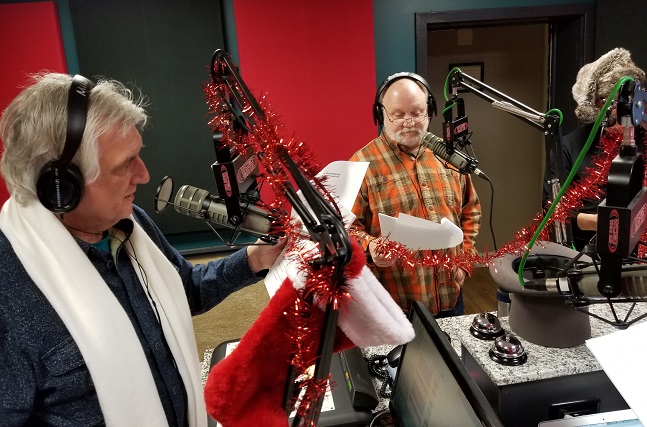December 24, 2017 – It’s a Wonderful Slice!
![]() Merry Christmahanakwanzika, everybody!
Merry Christmahanakwanzika, everybody!
Let me put it this way: if the guy in the White House is determined that everybody in America is going to say “Merry Christmas,” I can guarantee that I’m going to be a hold out. It’s not that I have anything against Christmas. It’s at least as good a holiday as, oh, Take Your Dog Groomer to Lunch Day. Maybe even a notch above. It’s just that I have absolutely no respect for the current occupant of the White House, so until he goes away, so does Christmas. At least for me. It’s that simple.
But that’s not going to stop me from following my own holiday traditions, including one that has lain fallow for four years now, and it’s time to bring it back.
I’m speaking of what used to be my annual presentation of It’s a Wonderful Slice of It’s a Wonderful Life. If you’re wondering exactly what that is, you need to tune into December 24 show or at least listen to the podcast once it’s posted. In a nutshell, I have a hunch that I was the first guy to distill the entire two and a half hour film It’s a Wonderful Life into a ten-minute performance piece.
How do I know that? Well, probably because I was doing it twenty years ago on a 50,000-watt radio station called WGN (also known in these parts as Gargantua Radio), so there’s probably an audio record of it somewhere–perhaps even on a cassette tape somewhere in my garage.
In the meantime, stage versions of the iconic movie have popped up like mushrooms after a rain storm. They include stage versions that perform it as a radio play, stage versions that basically re-do the movie, musical versions and even extremely truncated versions, like my own.
But remember that you read it here: I was the first.
I have performed my piece dozens of times in numerous venues over more than twenty years, including on the various incarnations of my radio program. Unfortunately, in the past three years, life got in the way, so this is the first time since 2013 that I’ve been able to do a radio version.
This triumphant (or not) return of It’s a Wonderful Slice to radio features the Not-Even-Ready-for-Weekends-Smart-Talk-Players. They are, in order of appearance, Bill Turck from Playtime with Sid & Bill, Featuring Kerri Kendall, Ron Cowgill from Mighty House Home Improvement Radio, and my very own co-host Peggy Malecki.
There has been no rehearsal, so you’ll be getting what you paid for. We hope you tune in anyway.
Here’s one more bit of information about the original film that is now considered a classic. It managed to land on the radar of the FBI, on the lookout for Communist influences following the end of World War II. According to the Smithsonian, an unidentified FBI agent
said it was “very entertaining.” However, writes scholar John A. Noakes, the agent “also identified what they considered a malignant undercurrent in the film.” As a result of this report, the film underwent further industry probes that uncovered that “those responsible for making It’s a Wonderful Life had employed two common tricks used by Communists to inject propaganda into the film.”
These two common “devices” or tricks, as applied by the Los Angeles branch of the Bureau, were smearing “values or institutions judged to be particularly American”–in this case, the capitalist banker, Mr. Potter, is portrayed as a Scroogey misanthrope–and glorifying “values or institutions judged to be particularly anti-American or pro-Communist”–in this case, depression and existential crisis, an issue that the FBI report characterized as a “subtle attempt to magnify the problems of the so-called ‘common man’ in society.”
But before we let show biz bust out all over the place, Peggy and I have to do at least one bit of serious business, so I’ll let her explain the first part of the show. Take it away, Peggy.
Counting the birds on Christmas Day
Each year, Audubon conducts its Christmas Bird Count, when citizen scientists and birdwatchers of all experience levels can join with a local organizer at a specific site and time to conduct a one-day census of local bird populations. This year marks the 118th count, and is happening across the U.S., Canada and in several other countries between December 14 and January 5. According to Audubon’s website,
“Each count takes place in an established 15-mile wide diameter circle, and is organized by a count compiler. Count volunteers follow specified routes through a designated 15-mile diameter circle, counting every bird they see or hear all day. It’s not just a species tally—all birds are counted all day, giving an indication of the total number of birds in the circle that day.”

Local bird conservationist Judy Pollock joins us in the studio this morning to talk more about the importance of citizen science, the annual bird count and some of the results so far. Through her company Judy Pollock Consulting, she advocates for increased bird habitats in the Chicago area and is a bird conservation consultant for Living Habitats, a Chicago-based landscape architecture company. Judy also co-founded the Bird Conservation Network and has been monitoring birds for the North Branch Restoration Project since 1995, and helped found the Bird Conservation Network Survey, what she calls “the largest local long-term citizen science breeding bird monitoring project in the nation”.
There are many opportunities to join in a Christmas Bird Count, but you need to pre-register. The Illinois Ornithological Society has a great map with dates and contact info on their website.
One of the birds you may be lucky enough to see in the Chicago area this season is the snowy owl, and we’ll talk with Judy about this magnificent artic bird that typically winters in the far north, but occasionally migrates to the northern U.S. and can be seen near the Great Lakes. Until recently, scientists knew little about this species. But thanks to technology, scientists are now studying the bird’s migration to determine population levels and learn how these birds are being affected by climate change.
According to the Lake County News Sun:
“This season is shaping up to be what birders and scientists are calling an invasion year for the nomadic hunter. It’s happening not only in Lake County, but also in Chicago and its collar counties, as far south as Quincy and also throughout the Midwest — especially along the Great Lakes shorelines. Wisconsin has already had 141 snowy owls reported, beginning in about November, said David Johnson, a field notes compiler for the Illinois Ornithological Society.”
Climate change may be affecting life cycles of both the owls and arctic lemmings, their main food supply. The Associated Press reports:
“… For researchers, this winter’s mass migration … is serious business. It’s a chance to trap and fit some of the visitors with tiny transmitters to help track them around the globe and study a long-misunderstood species whose numbers likely are far fewer than previously thought, researchers say.
Scientists began fitting the transmitters in the winter of 2013-14, when many owls last migrated to the U.S. To say they’ve been surprised by the results is an understatement, as the AP article continues:
“Instead of 300,000 snowy owls worldwide, as long believed, researchers say the population likely is closer to 30,000 or fewer. The previous estimate was based on how many might be able to breed in a given area. … The miscalculation doesn’t necessarily mean snowy owls … are in decline. Scientists simply don’t know because they never had an accurate starting point. This month, snowy owls were listed as vulnerable — one step away from endangered — by the International Union for Conservation of Nature. They’re protected in the U.S. under the Migratory Bird Act. “
We’re looking forward to talking with Judy about snowy owls and other overwintering birds, and ways we can help to support and protect their populations though techniques like bird-proofing windows. In fact, she recommends these tips from the Chicago Bird Collision Monitors website.


